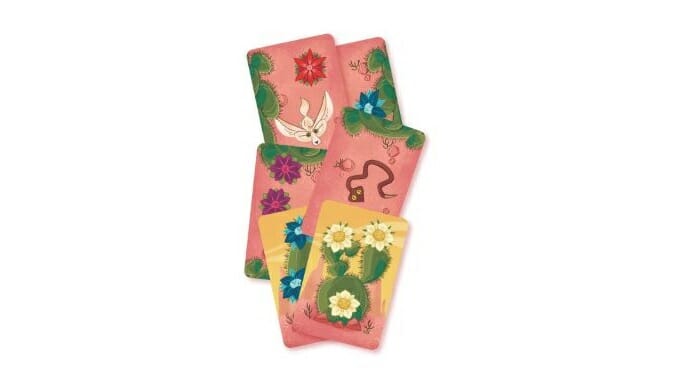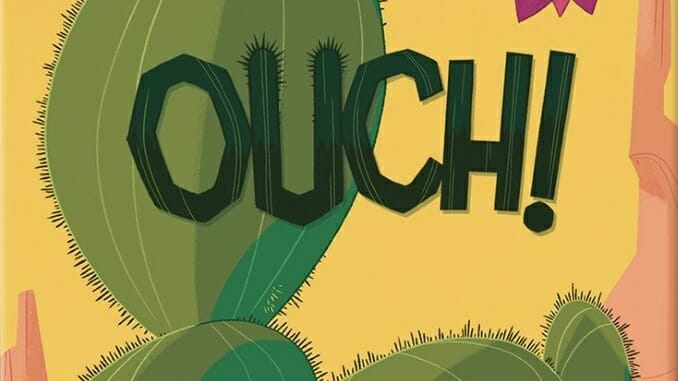Ouch! is a silly little small-box game for younger players, ages five and up, that combines the kind of funny elements that can keep a child’s attention with an actual game, although one that happens to be very luck-based.
In Ouch!, players will choose one of four cards from a central display and flip it over to see if they get to add the flowers depicted on the card to their collection. Flowers come in four different colors, and a card can show anywhere from one to three flowers on it. The twist is that you have to pick up the card by one of the four edges when you flip it, because some of the edges on the other side have cacti along them. If the edge where your fingers are has nothing on it, you get to keep the card. If that edge has a cactus on it, however, you lose the card—and, according to the rules, you must say “Ouch!” when it happens. If that card has a red flower on it, you also have to give up an additional card from the ones you’ve already gained. The more flowers there are on the front of a card, the more dangerous the card is to flip because more of its edges (up to three) will have cacti. The game ends when any player gets to keep their eighth card.
Some cards will also show you an animal on the reverse side when you flip it over, giving you an extra power if you get to keep the card (that is, if your finger isn’t pricked by a cactus). If you keep a card with a snake on it, and the player after you is pricked by a cactus, the player gives you that card rather than discarding it from the game. If you keep a card with a fennec—a real desert fox with impossibly large ears—then you get to take an extra turn, with a catch: if you get pricked when taking a second card, you lose that one and the card with the fennec on it.

The scoring is mostly straightforward. You get one point for each flower on the cards you’ve kept. You get four more points for each set of flowers in the four colors (individual flowers, not cards). And the player with the most red flowers gets a five point bonus. If you’re playing with especially young players, or just want the first game to be simpler, you can opt to skip either of the last two scoring options, or omit the animal cards from the initial deck (or just ignore them, and use them as regular flower cards).
I think self-serious board gamers will hate Ouch!, because so much of the game is purely random—but that’s true of just about every game for kids this young. Even some of the best games for kids ages 5+, like Dragomino and Ticket to Ride: First Journey, include some significant random elements, because that is an easy way to balance out the play between the younger kids and everyone else playing, whether adults or just older kids who have a better grasp of strategy or thinking a move or two ahead. The devil is in the details: how does the gamble handle that randomness? Can you play the game in a way that still makes sense, or that even uses the random aspects to your favor? And, most importantly, do the younger kids actually think it’s fun?
My go-to line on Candyland, a game of inexplicably enduring popularity, is that it is the perfect game to play with your kids if you want to teach them that life is pointless and random. There is one right way to play Candyland as a parent, and that is to shout “is that a bird outside?” so you can rig the deck to make the game end sooner the moment your highly gullible toddler looks out the window for the bird that, oh, dang, it just flew away. There is no game within Candyland. You don’t make any choices, and the winner is predetermined by the shuffling of the deck (or the card manipulations of the wise adult).
Ouch! has a high randomness factor involved, because there is no way to tell if the card you flip over will have a cactus on that particular edge. You do get to make decisions, though, given the information that more flowers = more cacti. Do you feel lucky? Or do you want to go slow and steady and grab cards with one flower, maybe diversifying to try to get the four point bonus for collecting all the colors, and hope you get your eighth card quickly? Kids won’t make that risk/reward calculation, although the game gives you a chance to explain the idea, but in my experience, they’ll just laugh whenever someone gets pricked, and they’re thrilled when they get to keep a card. It’s silly, yes, but it’s fun, it takes 10-15 minutes to play, and it plays anywhere from two to five players without much difference other than game time. For $10, it’s a way better value than the morbid, hours-long Candyland experience.
Keith Law is the author of The Inside Game and Smart Baseball and a senior baseball writer for The Athletic. You can find his personal blog the dish, covering games, literature, and more, at meadowparty.com/blog.

